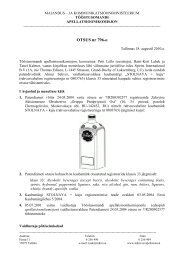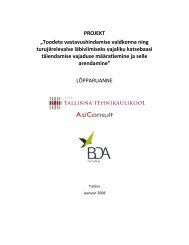Feasibility study for an Estonian Materials Technology Programme
Feasibility study for an Estonian Materials Technology Programme
Feasibility study for an Estonian Materials Technology Programme
You also want an ePaper? Increase the reach of your titles
YUMPU automatically turns print PDFs into web optimized ePapers that Google loves.
81<br />
<strong>Feasibility</strong> <strong>study</strong> <strong>for</strong> <strong>an</strong> Estoni<strong>an</strong> <strong>Materials</strong> <strong>Technology</strong> <strong>Programme</strong><br />
4. Conclusions <strong>an</strong>d recommendations<br />
Is there enough governmental money to succeed? How to choose the best as only a few investments<br />
c<strong>an</strong> be made.<br />
Is there enough experienced support in Estonia to coach start-up comp<strong>an</strong>ies <strong>an</strong>d make them succeed<br />
in global business?<br />
Note! These comp<strong>an</strong>ies need both money <strong>an</strong>d other type of support/coaching (business pl<strong>an</strong>ning,<br />
partner search/evaluation, legal support, facilities, etc.).<br />
4.2.3 Scenario 3: All National Public Funding of materials technology development is<br />
stopped<br />
Extreme scenario where all governmental funding to materials technology development <strong>an</strong>d the money is<br />
given to other technologies or developments.<br />
In 5-10 years<br />
Very little materials technology research left (mostly EU-funded).<br />
Most skilled people have retired or moved abroad. => Estonia loses the ability to underst<strong>an</strong>d how to<br />
apply new/right materials in new products.<br />
Some ef<strong>for</strong>ts have been put into technology scouting from abroad but due to lack of educated people<br />
<strong>an</strong>d technology know-how not a lot of new technologies are applied.<br />
Only big <strong>for</strong>eign owned comp<strong>an</strong>ies apply newest knowledge: Estonia is in the subcontracting role.<br />
The m<strong>an</strong>ufacturing industry will be in the same state as in 2011, but has lost market share <strong>an</strong>d competiveness<br />
as the world has moved on.<br />
The unlikely opportunities<br />
To survive, the m<strong>an</strong>ufacturing comp<strong>an</strong>ies start investing more in R&D.<br />
University personnel are employed by comp<strong>an</strong>ies => R&D done there.<br />
As materials technology is a key enabler in m<strong>an</strong>y areas (such as biotechnology, energy technology etc.) it<br />
is unlikely that its funding will be stopped completely as it is a part of the development chain.<br />
In this scenario, the renewal of the m<strong>an</strong>ufacturing industry suffers most.<br />
4.3 Estoni<strong>an</strong> materials technology programme<br />
4.3.1 Assessment of necessity<br />
There are very m<strong>an</strong>y public initiatives to increase collaboration: competence centres, technology programmes<br />
<strong>an</strong>d cluster development programmes. In addition, m<strong>an</strong>y other funding instruments <strong>for</strong> starting<br />
a comp<strong>an</strong>y already exist or are being pl<strong>an</strong>ned (innovation voucher, education, SPINNO) etc.<br />
M<strong>an</strong>y programmes are working in highly overlapping areas <strong>an</strong>d thus it is very difficult to identify the<br />
relev<strong>an</strong>t ones <strong>for</strong> industrial comp<strong>an</strong>ies<br />
Most of the innovation development is highly dependent on EU structural funds <strong>an</strong>d there<strong>for</strong>e the<br />
impact of decreasing funding at some point may create a shock adversely affecting innovation activities.<br />
It may be very difficult to position materials technology programme among other public support <strong>an</strong>d<br />
funding instruments as m<strong>an</strong>y of the leading innovating comp<strong>an</strong>ies already belong to multiple clusters<br />
<strong>an</strong>d thus a new programme is likely to increase the amount of bureaucracy.<br />
A small country (as a small comp<strong>an</strong>y) has to be very flexible <strong>an</strong>d ch<strong>an</strong>ge quickly according to emerging<br />
trends <strong>an</strong>d societal needs.<br />
It is cheaper to find the best technology abroad.<br />
It is very expensive to develop in house.<br />
However, with the development knowledge (as well as with knowledge of basic sciences) it is easier to<br />
apply new knowledge quicker.<br />
However, in Estonia materials technology research plays a fundamental role in developing knowledge <strong>an</strong>d<br />
skills <strong>for</strong> the future.





